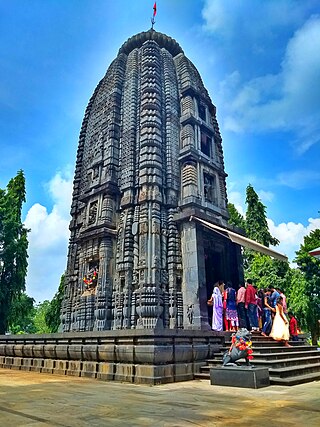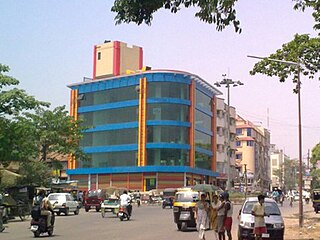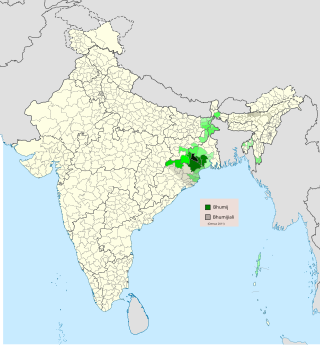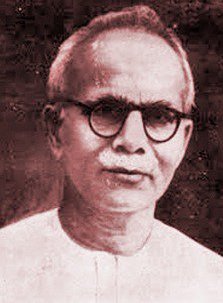
Odia is an Indo-Aryan classical language spoken in the Indian state of Odisha. It is the official language in Odisha, where native speakers make up 82% of the population, and it is also spoken in parts of West Bengal, Jharkhand, Andhra Pradesh and Chhattisgarh. Odia is one of the many official languages of India; it is the official language of Odisha and the second official language of Jharkhand.

Mayurbhanj district is one of the 30 districts in the Odisha state of eastern India. It holds the distinction of being the largest district in Odisha by area. The district's headquarters is located in Baripada, with other major towns including Rairangpur, Karanjia, and Bahalda. As of 2011, Mayurbhanj ranks as the third-most populous district in Odisha, following Ganjam and Cuttack.
Ho is a Munda language of the Austroasiatic language family spoken primarily in India by about 2.2 million people per the 2001 census. Ho is a tribal language. It is spoken by the Ho, Munda, Kolha and Kol tribal communities of Odisha, Jharkhand, Bihar, Chhattisgarh, West Bengal, Assam and is written with the Warang Citi script. Devanagari, Latin script, Odia script and Telugu script are sometimes used, although native speakers are said to prefer a Ho script. The latter script was invented by Ott Guru Kol Lako Bodra.

East Singhbhum is one of the 24 districts of Jharkhand, India. It was created on 16 January 1990. More than 50% of the district is covered by dense forests and mountains, where wild animals once roamed freely. It is known for being a centre of industry since Jamshedpur, the most populous city in Jharkhand, is located here.

West Singhbhum or Pashchimi Singhbhum is one of the 24 districts of Jharkhand state, India. It came into existence on 16 January 1990, when the old Singhbhum district was bifurcated. Chaibasa is the district headquarters.

Seraikela-Kharsawan district or Saraikella and Kharaswan district is one of the twenty-four districts of Jharkhand state in eastern India. Seraikela town is the district headquarters of Saraikela Kharsawan district. The district is well known for Seraikela Chhau, one of the three distinctive styles of the chhau dance. This district was carved out from West Singhbhum district in 2001. The district was formed from the princely states of Seraikela and Kharaswan, after the independence of India.

Sundargarh District is a district in the northwestern part of Odisha state in eastern India.

Chakradharpur is a municipal town situated in the West Singhbhum district of Jharkhand, India, positioned strategically on the Chota Nagpur Plateau. Located 62 kilometers west of Jamshedpur, 115 kilometers south of Ranchi, and 101 kilometers east of Rourkela, it serves as a crucial hub for the mineral-rich regions of Jharkhand and Odisha, as well as for the cement, steel, and limestone industries in the vicinity. The town spans an urban area of 10 square kilometers and stands at an elevation of 227 meters. It shares its borders with Jamshedpur to the east, Rourkela to the west, Ranchi to the north, and Chaibasa to the south, which also serves as the district headquarters of West Singhbhum.
Mundari (Munɖari) is a Munda language of the Austroasiatic language family spoken by the Munda tribes in eastern Indian states of Jharkhand, Odisha and West Bengal and northern Rangpur Division of Bangladesh. It is closely related to Santali. Mundari Bani, a script specifically to write Mundari, was invented by Rohidas Singh Nag. It has also been written in the Devanagari, Odia, Bengali, and Latin writing systems.

South Koel River is a 285 kilometres (177 mi) long river which runs across Jharkhand and Odisha states in India. It originates on the Lawapani Waterfalls, near Lohardaga, Chota Nagpur Plateau a Lawapani Waterfalls, near Lohardaga, Chota Nagpur Plateau 82.5 kilometres (51 mi) from Ranchi, and conjoins the Belsiangar and Singbhum Rivers. The Koel is fed by three streams in Jharkhand, namely the North Karo, South Karo and Koina. The South Koel enters Odisha and joins with Sankh River at Vedavyas near Rourkela from where it is named as Brahmani.
The Koina River flows through West Singhbhum in the Indian state of Jharkhand.

Bhumij is an Austroasiatic language belonging to the Munda subfamily, related to Ho, Mundari, and Santali, primarily spoken by Bhumij peoples in the Indian states Jharkhand, Odisha and West Bengal. As per the 2011 census, only 27,506 people out of 9,11,349 Bhumij people spoke Bhumij as their mother tongue, as most Bhumijas have shifted to one of the regional dominant languages. Thus the language is considered an extremely endangered language.

Pandit Godabarish Mishra was a poet and notable socialist from Odisha, India. He is known for his contribution to Odia literature.
Manbhumi or Manbhumi Bengali is the local Bengali dialect spoken in the district of Purulia, and adjacent area of other districts of West Bengal and Jharkhand, previously Manbhum, in Eastern India. It is one of the Bengali dialects, having some influences of neighbouring dialects of Hindi and Odia in it.
Baharagora College, established in 1969, is a general degree college in the East Singhbhum district. It offers undergraduate and postgraduate courses in arts, commerce and sciences. It is affiliated to Kolhan University.
Potka block is a CD block that forms an administrative division in the Dhalbhum subdivision of East Singhbhum district, in the Indian state of Jharkhand.
Dumaria block is a CD block that forms an administrative division in the Ghatshila subdivision of East Singhbhum district, in the Indian state of Jharkhand.
Gurbandha block is a CD block that forms an administrative division in the Ghatshila subdivision of East Singhbhum district, in the Indian state of Jharkhand.
Baharagora block is a CD block that forms an administrative division in the Ghatshila subdivision of East Singhbhum district, in the Indian state of Jharkhand.
Gour or Goud is a caste of Jharkhand similar to Gopal (caste) of Odisha. Locally they are also known as Ahir, Gour Gowala. Most of them speak the local form of Odia language which they lebel as Singhbhumi Odia.









